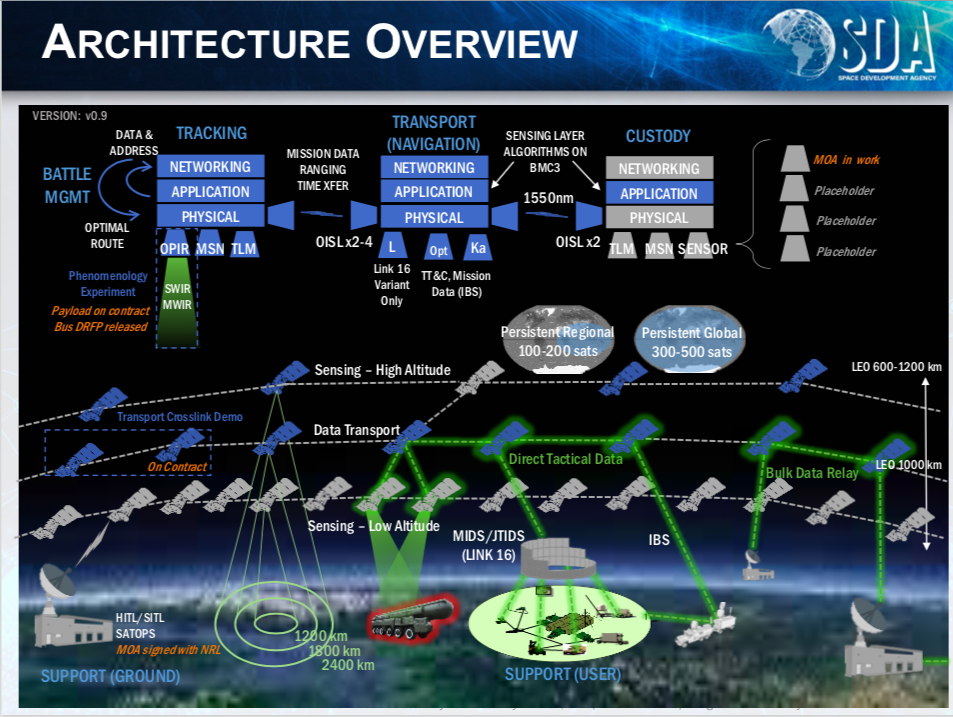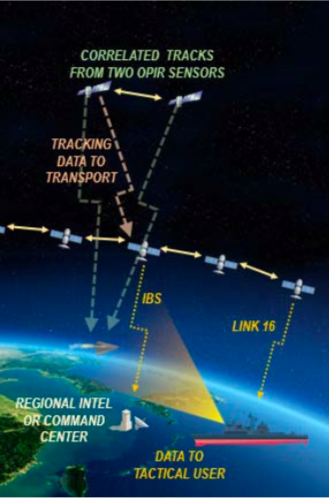
SDA’s latest “objective” space architecture
WASHINGTON: The Space Development Agency (SDA) has dropped plans to include a new set of tracking satellites designed to deter adversaries in cislunar space.
“The department decided that due to funding constraints, there were higher priority places to put that funding,” SDA head Derek Tournear told reporters last week. “So, right now that is for the study phases.”
As Breaking D readers know, military leaders have become increasingly agitated about the potential for adversaries (read China) to undertake military operations in cislunar space, the region between Geosynchronous Orbit (GEO, 36,000 kilometers in altitude) and the Moon. SDA’s original “notional” architecture included only 200 satellites for monitoring that region and at least three “advanced maneuvering vehicles” (AMVs) that would operate like mini-space planes (think the X-37B on steroids) and carry unspecified capabilities to counter adversary spacecraft.
SDA now has relegated cislunar tracking to one of several planned studies on “emerging technologies;” neither its various briefing charts provided to industry nor Tournear mentioned the AMV concept.
Industry has until April 17 to provide feedback on SDA’s initial draft Request For Proposals (RFP), with the agency offering one-on-one consultations until April 13. The final draft is to be released on May 1.
The draft RFP is focused on what SDA calls a “data transport layer” designed to allow low-latency communications (that is, with only small lag time between the sender and the receiver). It will use optical cross-links between satellites, and link to users on the ground via the venerable Link 16 system used widely by the services and allies, and the Integrated Broadcast System (IBS) that carries Ultra-High Frequency (UHF) communications.
The mission of the initial transport layer is “to demonstrate a capability of a mesh network in space,” Tournear said. It will comprise 20 satellites to be launched in 2022. SDA has budgeted $100 million for those satellites in 2021, he added.
This first small constellation has been designated as “Tranche 0” of SDA’s multi-phased spiral development effort to build its “objective” space architecture that will see new satellites with new capabilities launched every two years, Tournear explained. The end goal is a multi-layered network of various satellite constellations for sensing, tracking space objects, data transport, and communications.
Development of a data transport mesh network, enabled by optical satellite cross-links, is a key enabler for DoD’s high-priority Joint All-Domain Command and Control (JADC2) effort, Tournear said. Indeed, he said, part of SDA’s role is to ensure “the unifying effort on the space side for JADC2.”
As Breaking D has reported extensively, JADC2 is the concept of operations, and the technology, to allow DoD to connect all available sensors (including commercial satellites) to all shooters for lightning fast and highly accurate targeting and C2.

SDA’s data transport layer
According to Tournear, and the slides presented to industry during an April 2 introductory industry day, there are six goals to be met by this first SDA effort. These are:
- Low-Latency Data transfer
- Transmit/Receive Wideband Data
- Demonstrate Limited battle management command, control and communication (BMC3)
- Transport Bulk IBS Data (narrowband UHF)
- Link-16 Messages to warfighers on the ground
- Common Relative Time Reference, i.e. an ability to maintain its own timing signature separate from GPS position, timing and navigation satellites.
Tournear said that more than 500 industry reps attended the industry day, originally slated to take place at the annual Space Symposium in Colorado Springs but instead done virtually because of the COVID-19 pandemic.
“The ability to rapidly move time-sensitive data between proliferated assets and across multiple domains is absolutely critical,” Aaron Rogers, Maxar Technologies’ director of National Programs said in a statement to Breaking D yesterday. “We’re pleased to see that the Space Development Agency is seeking to leverage the proven agility and innovation found within the commercial space industry to affordably and reliably deliver its transport layer satellite constellation. Maxar is studying the mission requirements to decide how to propose a solution for this program.”
Another industry source said one of the key questions — besides how SDA will operate and be funded once it is folded into the Space Force — is how the agency intends to convince firms to turn over their intellectual property related to the satellite design. This could be a real barrier to participation by small firms and startups, the source explained.
Taking aim: Army leaders ponder mix of precision munitions vs conventional
Three four-star US Army generals this week weighed in with their opinions about finding the right balance between conventional and high-tech munitions – but the answers aren’t easy.


























